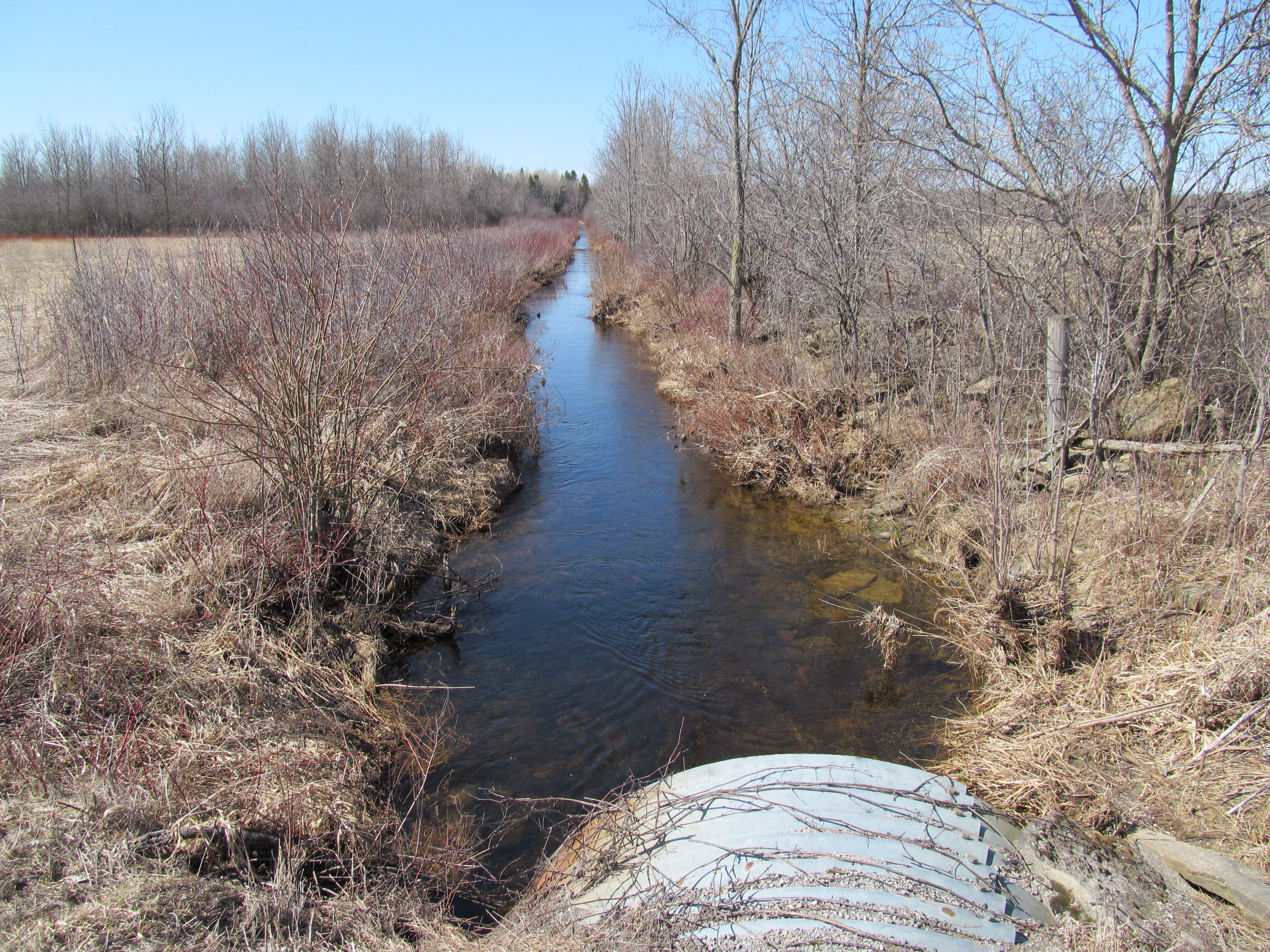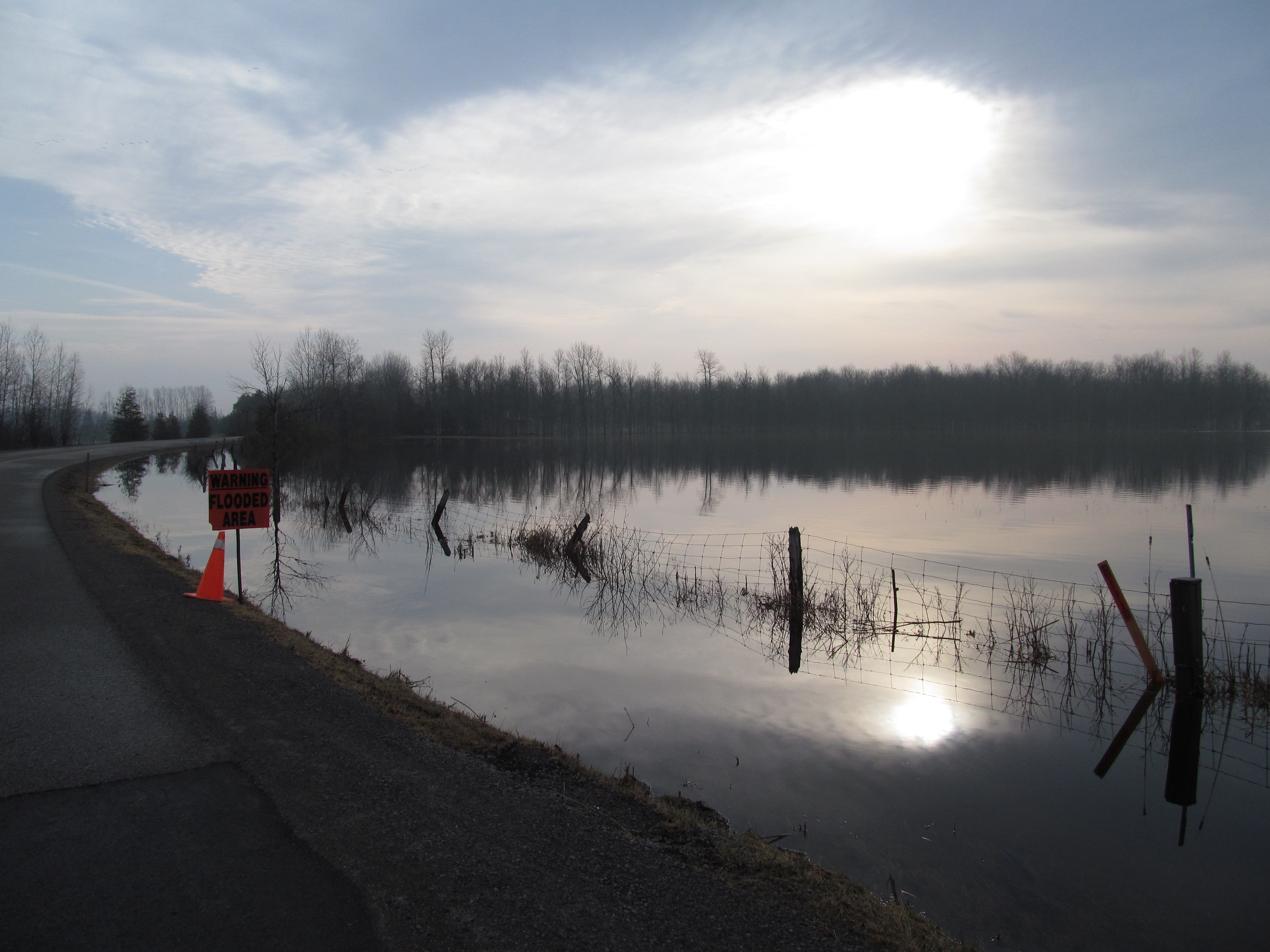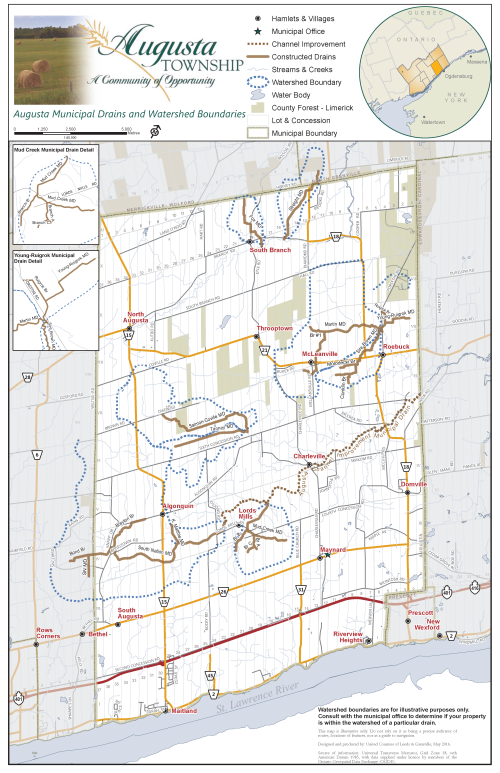Augusta Township has a long history of drainage issues and remedies. Some of the municipality’s drainage records date back to the late 1800s. An 1830’s map of the municipality shows a large area in the 6th and 7th concessions as the “Big Swamp”. Augusta Township was definitely an area that required drainage in order for agriculture to prosper.
Surface Water Drainage
Drainage, both in its natural form and man-made, comes in many forms. Under English Common Law, no right of drainage of mere surface water exists as long as the flow is not in a defined channel. The owner of lower land may, by their own choice, either allow water from higher land to flow over it or keep such water off their property by dams or banks.
Natural Watercourses
Once surface water is gathered into a defined channel it is considered a natural watercourse. The holders of lands that abut a natural watercourse are referred to as riparian owners. A riparian owner is not only entitled to have the water of a stream passing through their land flow to them in its natural state, so far as it is a benefit to them, but they are also bound to submit to receive it so far as it is a nuisance to them by its tendency to flood their lands. To learn more about surface water and natural watercourse rights refer to the factsheet “Top 10 Problems Between Rural Neighbours” produced by the Ontario Ministry of Agriculture and Rural Affairs. OMAFRA also has information with respect to “Drainage Problems With Your Neighbours”.
Private Drains
A private drainage system is constructed by a property owner to resolve their own drainage problems. These systems are  usually a ditch, buried pipe or grassed waterway, and collect or concentrate surface water. Roadside ditches are another form of private ditch. Property owners have no right to drain their private ditches into a roadside ditch without the agreement of the municipality. Whatever form ditches take, they must be taken to a “sufficient outlet”, whether on the landowner’s own property; to a natural watercourse that abuts their property; or to a municipal drain (see below). Whatever route is chosen, the property owner needs to contact environmental agencies (Ontario Ministry of Natural Resources and Forestry, local Conservation Authority) to ascertain if any authorizations are required. Any drainage work within 120 metres of a Provincially Significant Wetland (PSW) will require conservation authority approval and may require a wetland impact study. No development (i.e. drainage) can be undertaken in the wetland itself.
usually a ditch, buried pipe or grassed waterway, and collect or concentrate surface water. Roadside ditches are another form of private ditch. Property owners have no right to drain their private ditches into a roadside ditch without the agreement of the municipality. Whatever form ditches take, they must be taken to a “sufficient outlet”, whether on the landowner’s own property; to a natural watercourse that abuts their property; or to a municipal drain (see below). Whatever route is chosen, the property owner needs to contact environmental agencies (Ontario Ministry of Natural Resources and Forestry, local Conservation Authority) to ascertain if any authorizations are required. Any drainage work within 120 metres of a Provincially Significant Wetland (PSW) will require conservation authority approval and may require a wetland impact study. No development (i.e. drainage) can be undertaken in the wetland itself.
Award Drains
If the ditching needs to be undertaken on two or more properties, provincial legislation over the years has allowed for a number of approaches. Under the Ditches and Watercourses Act (repealed in 1963 after almost a hundred years) the work of constructing ditches across multiple properties was “awarded” to persons along the ditch. These Award ditches are still in effect today although obtaining copies of the agreements may be difficult. As with private drains, property owners wishing to repair or maintain an award drain need to contact environmental agencies (Ontario Ministry of Natural Resources and Forestry, local Conservation Authority) to ascertain if any authorizations are required.
Mutual Agreement Drains
The Drainage Act, 1975, allows for two or more owners to enter into a written agreement for the construction, improvement, financing and maintenance of drainage works. The signed agreements may be registered with the municipality and/or the local land registry office. The agreement is binding on subsequent owners of the land that is the subject of the agreement. There are a number of advantages and disadvantages to using a mutual agreement drain process. As with other drains, approval from environmental agencies may be required.
Municipal Drains
Municipal drains have existed in Ontario for over a hundred years. Most were/are constructed to improve the drainage of agricultural land by serving as a discharge point for both open channel drains and tile drainage systems. They also remove excess water collected by roadside ditches, residential lots, institutional and industrials lands and any other properties in rural areas. Municipal drains are constructed under the authority of the Drainage Act. Landowners requiring drainage petition the municipality. If certain criteria are met, the municipality appoints an engineer who prepares a report. The Engineer’s Report identifies the proposed solution to the problem and how the costs will be shared. Through a series of public meetings and several appeal stages, objections are heard and dealt with. If the drain is to proceed, the municipality passes a by-law adopting the engineer’s report. The project is then constructed by the municipality.
improve the drainage of agricultural land by serving as a discharge point for both open channel drains and tile drainage systems. They also remove excess water collected by roadside ditches, residential lots, institutional and industrials lands and any other properties in rural areas. Municipal drains are constructed under the authority of the Drainage Act. Landowners requiring drainage petition the municipality. If certain criteria are met, the municipality appoints an engineer who prepares a report. The Engineer’s Report identifies the proposed solution to the problem and how the costs will be shared. Through a series of public meetings and several appeal stages, objections are heard and dealt with. If the drain is to proceed, the municipality passes a by-law adopting the engineer’s report. The project is then constructed by the municipality.
The cost of the construction is assessed to the lands within the watershed as either benefit or outlet or both, based on an assessment schedule prepared from the engineer’s report. Once constructed, the municipal drain becomes municipal infrastructure. Through its drainage superintendent, the municipality has the responsibility to repair and maintain the drain. Landowners within the watershed can also request that the drain be repaired or maintained. Repair and maintenance costs are also assessed to the lands within the watershed.

Municipal Drains in Augusta Township
The municipality currently has 11 municipal drains within the watersheds of Kemptville Creek and the South Nation River. Many of the drains have branches (secondary drains) that form part of the municipal drain.
Kempville Creek Watershed
Fox Municipal Drain
Streight Municipal Drain
South Nation River Watershed
South Nation Municipal Drain (Main Drain, Brayton Branch, Bond Branch)
Augusta Channel Improvement Municipal Drain
Mud Creek Municipal Drain (Main Drain, Branch “A”, Branch “B”, Branch “C”)
Salmon-Coville Municipal Drain
Tanney Municipal Drain
K. Matthie Municipal Drain
Martin Municipal Drain (Main Drain, Branch # 1)
Sire Brown Municipal Drain (Main Drain, Moledecki Branch, Conklin Branch)
Young-Ruikrok Municipal Drain (Main Drain, Ruigrok Branch)
The above noted municipal drains and their watersheds are shown on the map below. The map has been prepared for illustrative purposes only. If you have any questions with respect to your property and a municipal drain, please contact the municipal office.
Do and Don’t
You, as a landowner or as a potential landowner in the municipality, should:
- If you know there is a municipal drain on your property, find out how the municipal drain affects your property. How much is your property assessed?
- If you notice any problems with the municipal drain, immediately notify the Municipality.
- Before purchasing a property, investigate how municipal drains may affect it.
You should not:
- Obstruct access. Along every municipal drain is an unregistered work space that the municipality has the right to use to maintain or repair the drain. Please keep this work space accessible.
- Store materials (i.e. brush or other floatable material) near the drain. During storm events and spring runoff this material may block the drain.
- Perform any work on the drain yourself (including, but not limited to, the installation of crossings). Notify the Municipality to arrange for maintenance or the installation of a crossing on a municipal drain.
- Direct septic system waste, milkhouse waste, barnyards and manure storage runoff or other pollutants to these drains.
Tile Drainage
Augusta Township administers the Tile Drainage Program whereby loans for tile drainage are available to property owners in the farm land tax class. Application forms and application guidelines are available from the municipal office.
Terms of the Loan:
- All loans have a 10 year term and are repaid via your property tax notices
- Interest rates may vary but are currently 6%
- Landowners are eligible for a loan of 75% of the cost of the drainage work, up to $50,000
- The loan can be repaid in full at any time
*No tile drainage can be undertaken within 120 metres of a Provincially Significant Wetland (PSW) without approval from the local conservation authority. A wetland impact assessment that demonstrates what impact the drainage works will have on the PSW’s hydrologic function may also be required.
Tile Drainage Loan Application Form *note: if the form does not open, try opening it using a different browser.
For more information on the Tile Drainage Program, please visit the OMAFRA website.







